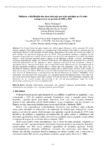Please use this identifier to cite or link to this item:
http://www.alice.cnptia.embrapa.br/alice/handle/doc/902195| Title: | Dinâmica e distribuição das áreas alteradas por ação antrópica no Cerrado matogrossense no período de 2002 a 2008. |
| Authors: | TRABAQUINI, K.  SILVA, G. B. S. da   TAKEDA, M. M. G.   FORMAGGIO, A. R.   SIMABUKURO, Y. E.   |
| Affiliation: | KLEBER TRABAQUINI, INPE; GUSTAVO BAYMA SIQUEIRA DA SILVA, CNPM; MARIANE MAYUMI GARCIA TAKEDA, INPE; ANTONIO ROBERTO FORMAGGIO, INPE; YOSIO EDEMIR SHIMABUKURO, INPE. |
| Date Issued: | 2011 |
| Citation: | In: SIMPÓSIO BRASILEIRO DE SENSORIAMENTO REMOTO, 15., 2011, Curitiba. Anais... São José dos Campos: INPE, 2011. |
| Pages: | p. 6642-6649. |
| Description: | The Cerrado biome has approximately two million square kilometers, which represents 23% of the country extension. With a large territory, it is considered one of the hotspots of the Planet, ie, a priority area for conservation. However, with favorable soil and climate characteristics, this biome has become the subject of great affluence for agricultural purposes since the 1970s. With government incentives, conditions for the expansion of agriculture were created. All these factors were decisive to the expansion of so-called "agricultural frontier?, which provided important positive impacts on the Brazilian economy. However, concomitantly, increasing environmental changes are observed in this biome. The anthropogenic occupation has as the first action the deforestation and the reduction of native vegetation, and much of this occupation is linked to agricultural activity. Among several States which compose this biome, Mato Grosso has a prominent place in national agricultural production, primarily due to soybean and corn plantations. Thus, this study aims to determine the dynamics and the spatial distribution changes due to anthropogenic activities in the Cerrado of Mato Grosso state in the 2002 to 2008 time period. The deforested data from the analyzed period were obtained from ?Projeto de Monitoramento do Desmatamento dos Biomas Brasileiros por Satélite? (PMDBBS). These information were intersected with mesoregions, soil, vegetation and geomorphological maps of the study area. The results showed that highest conversions occurred in North mesoregion. The predominant vegetation type deforested was the wooded savanna and according to the soil and geomorphological maps, the results demonstrated a preference for deep soils and plan relief. |
| Thesagro: | Desmatamento Geomorfologia Solo |
| Keywords: | Savana Mesorregiões Vegetação potencial |
| Type of Material: | Artigo em anais e proceedings |
| Access: | openAccess |
| Appears in Collections: | Artigo em anais de congresso (CNPM)  |
Files in This Item:
| File | Description | Size | Format | |
|---|---|---|---|---|
| GustavoSBSR.pdf | 422,65 kB | Adobe PDF |  View/Open |









